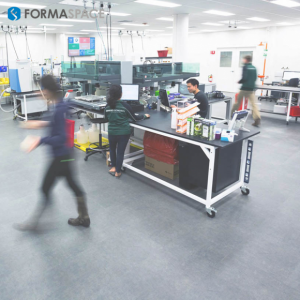
Remote Diagnostics for Healthcare & Medical Device Equipment Maintenance

Formaspace manufactured this custom “Scissors” conference table for a telemedicine environment where doctors confer on difficult diagnoses. The 18′ table can open or close depending on the conference seating and viewing requirements.
Find out what are the pros and cons healthcare IT managers should consider before adopting new remote healthcare diagnostics systems.
Over the past year, the Coronavirus pandemic has brought about changes to nearly every industry.
In the healthcare segment, telemedicine adoption rates have skyrocketed in direct response to the pandemic lockdown.
Now, healthcare executives are looking at ways to combine the benefits of on-site doctor visits with the convenience of telemedicine – by making new investments in remote healthcare diagnostic systems.
But what do we mean exactly by remote healthcare diagnostics?
It turns out the most common example may be on your wrist.
New generation smartwatch solutions from Apple, Kardia, Samsung, and other vendors now offer heart rate pulse analysis using photoplethysmography (PPG) technology, which can help users identify undiscovered cases of Atrial fibrillation (AF).
In addition to detecting incidents of AF, the Apple Watch Series 4 also received FDA “clearance” as a Class II Medical Device as a single-lead electrocardiogram (ECG) recording device (Apple claims it can record results in just 30 seconds), it can also detect accidental falls (if the wearer does not get back up, the watch will call emergency responders automatically).
These watches fall into one of the fastest-growing segments in healthcare: Home Healthcare Medical Devices (HHMDs), which are designed to allow patients to perform basic home health tests without the need of specialists to operate them.
However, like many HHMDs, these new watches are far from capable of replacing a full suite of diagnostic equipment that a medical provider would need to substitute for an in-office visit.
For example, Apple has not sought clearance for its built-in oximeter, which is presumed not to be accurate enough to get a nod from the FDA. (In lieu of FDA clearance, Apple is free to market its oximeter as a “wellness” feature instead.)
At the other end of the remote diagnostics spectrum are Class III devices, the FDA’s most stringent category for medical devices – including all embedded medical devices (EMDs) such as pacemakers and implantable cardiovascular defibrillators (ICDs).
Here, the classic example of a remote diagnostic medical device technology is the combination of an insulin pump (the first implantable version appeared in 1984) with an embedded continuous glucose monitoring (CGM) system (first introduced in 2005). Over time, these devices have become smaller and “smarter,” allowing the combined system to automatically control insulin delivery using Closed-loop control (CLC) technology. More recently, these devices have gained the ability to “phone home” using mobile wireless technology to upload data to healthcare providers who provide “decision support” on patient care using the very accurate data records collected by the devices embedded in the patient.
Remote Diagnostic Systems Help Doctors Provide Quality Medical Care To Patients During Emergencies Or To Remote Locations Without Nearby Healthcare Options
As we pointed out in the introduction, the Coronavirus pandemic has accelerated the acceptance of telemedicine by patients, healthcare systems, and insurance companies by years, if not by a full decade.
This is creating a growing market for connected mHealth (mobile health) devices, which were once originally targeted for use by emergency responders or healthcare providers servicing remote areas or third-world countries with few local healthcare options.
Rapid advances in device miniaturization and increased power and flexibility of sensor devices powering the newest generations of these remote diagnostic devices are offering healthcare providers a tantalizing choice: could these devices offer the next best thing to examining a patient in person?
One recent example that’s come to market is the IDIS2GO diagnostic toolkit from the Austrian company SK Telemed.
This product features a basic set of diagnostic tools that fit into a small doctor bag (including temperature, pulse rate, blood oxygen levels, blood pressure, blood glucose level, basic urine analysis, respiratory function tests, electrocardiogram, and dermoscopic examination tools). It is supported by a camera and audio communication that allow a healthcare provider or EMT to conduct a typical physical exam as part of a telehealth visit. Collected data is sent to the company’s cloud data server, where it can be accessed by the healthcare provider. The system also provides built-in AI-powered analysis to provide design support assistance to the healthcare provider.
Will devices such as these become mainstream healthcare tools? The likely answer is not yet. Much depends on whether patients can use these systems effectively without in-person oversight. We discuss the key questions that healthcare providers need to answer before making remote diagnostic tools widely available for use in patient homes in the sections below.
Manufacturers And Maintenance Service Organizations Are Using Remote Diagnostic Tools To Manage, Upgrade, And Troubleshoot Equipment In Clinical Healthcare Settings
Alongside the rapid growth of telehealth during the Coronavirus pandemic, we’ve also seen a rapid uptake in the use of remote diagnostics by manufacturers (or maintenance organizations) – allowing them to repair medical equipment located in healthcare settings without having to come on-site for an in-person service call.
This type of remote service goes by many names, depending on the industry. It’s variously called Intelligent Device Management (IDM), Strategic Service Management (SSM), or Remote Device Management (RDM) – which is the term we will use here.
The ability of machines located in the field to phone home to their OEM manufacturer or maintenance organization is not new. One of the first industries to implement this was the airline business, which introduced Aircraft Communications Addressing and Reporting System (ACARS) back in 1978, using Telex technology (!) to send error reports via radio (and later satellite) datalinks.
More recently, most of us have experienced IT Help desks performing remote logins to access the computers we use for work to solve problems we have with our software programs or hardware devices.
Similar RDM technology is now becoming common among healthcare devices, which is good news for healthcare systems that need to keep critical equipment, such as CAT scan machines, in proper working order to avoid disruptions in inpatient care.
In the past, many of these high-tech devices, such as CAT scan machines, required on-site visits when things go wrong, even if it was just a minor faulty adjustment or unintentional user error. In response, many manufacturers are investing in enhanced diagnostic systems that allow off-site factory technicians to diagnose equipment errors and fine-tune their performance.
In many cases, manufacturers are also turning to augmented reality systems to allow healthcare technical staff and the manufacturer’s support team to work together (See the GE implementation in the video above), to diagnose and make adjustments (or even simple repairs) without the need for an on-site service call.
Healthcare CIOs Need To Understand The Advantages And Disadvantages Of Remote Diagnostics Systems Before Jumping Into An Implementation
As we all know, clinical healthcare is a highly regulated field, which makes it difficult to integrate new, heterogeneous patient care systems into your existing set of standard operating procedures and compliance protocols.
Read more...
Julia Solodovnikova
Formaspace
+1 800-251-1505
email us here
Visit us on social media:
Facebook
Twitter
LinkedIn
EIN Presswire does not exercise editorial control over third-party content provided, uploaded, published, or distributed by users of EIN Presswire. We are a distributor, not a publisher, of 3rd party content. Such content may contain the views, opinions, statements, offers, and other material of the respective users, suppliers, participants, or authors.



